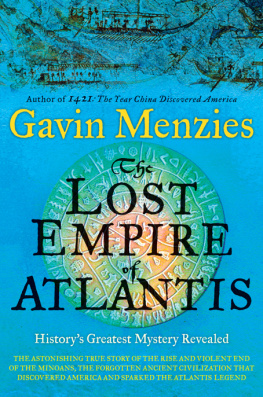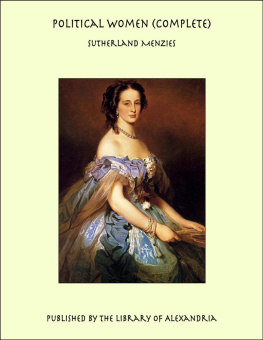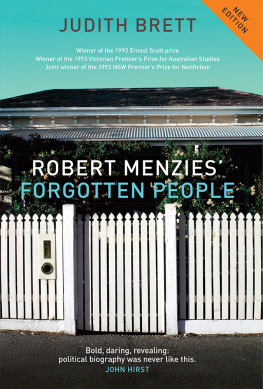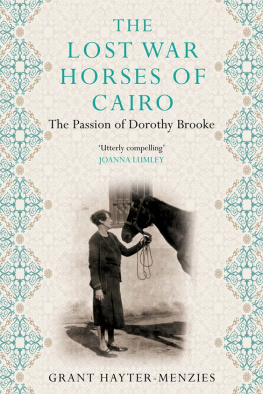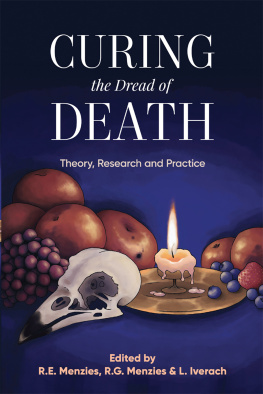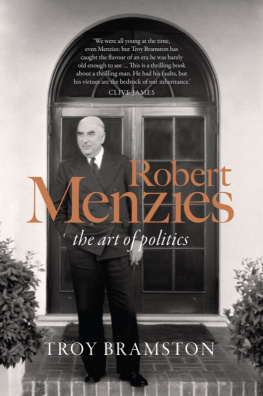MENZIES AT WAR
ANNE HENDERSON is deputy director of the Sydney Institute, which she has operated with her husband, Gerard Henderson, a well-known political commentator, since 1989. She also edits the Sydney Papers Online and co-edits the Sydney Institute Quarterly. Anne Henderson is the author of From All Corners: Six Migrant Stories (1993), Educating Johannah: A Year in Year 12 (1995), Mary MacKillops Sisters: A Life Unveiled (1997), Getting Even: Women MPs on Life, Power and Politics (1999), The Killing of Sister Irene McCormack (2002) and An Angel in The Court: The Life of Major Joyce Harmer (2005). Among her essays of note are Dads wake in Fathers: In Writing (1997) and the biographical chapter on Prime Minister Joseph Lyons for Australian Prime Ministers edited by Michelle Grattan (2000) and the United Kingdoms New Dictionary of National Biography. She was a contributing editor with Ross Fitzgerald of Partners (1999). In 2008 she published Enid Lyons: Leading Lady to a Nation, and in 2011 Joseph Lyons: The Peoples Prime Minister.
MENZIES AT WAR
ANNE HENDERSON

A NewSouth book
Published by
NewSouth Publishing
University of New South Wales Press Ltd
University of New South Wales
Sydney NSW 2052
AUSTRALIA
newsouthpublishing.com
Anne Henderson 2014
First published 2014
This book is copyright. Apart from any fair dealing for the purpose of private study, research, criticism or review, as permitted under the Copyright Act, no part of this book may be reproduced by any process without written permission. Inquiries should be addressed to the publisher.
National Library of Australia Cataloguing-in-Publication entry
Author: Henderson, Anne, 1949 author.
Title: Menzies at war/Anne Henderson.
ISBN: 9781742233796 (paperback)
9781742246987 (ePDF)
9781742241791 (ePub/Kindle)
Notes: Includes index.
Subjects: Menzies, Robert, Sir, 18941978.
Prime ministers Australia Biography.
Politicians Australia Biography.
Australia Politics and government 20th century.
Dewey Number: 994.04092
Cover design Josephine Pajor-Markus
Fron cover image Robert Menzies gives a victory salute. c. 1954, Fairfax FXJ98734.


Produced with the assistance of Kooyong 200 Club
All reasonable efforts were taken to obtain permission to use copyright material reproduced in this book, but in some cases copyright could not be traced. The author welcomes information in this regard.
Contents
Foreword
Robert Menzies remains the giant of Australian politics. Even those who challenge the principles he espoused, and oppose the goals he pursued, concede that he was a giant though they wish he had been toppled. He was prime minister longer than any of the nations leaders before or after. When he stepped down in 1966, he had led the Commonwealth of Australia for almost one-third of its history.
He had sustained or presided over a period of remarkable prosperity and national growth. Though he is now seen as British to the bootstraps, he was also a nationalist, and it was in his last year that East Asia suddenly replaced Britain as our main trading partner. He is widely seen as vigorously anti-Labor in his ideology, but he usually stood near the middle of the political compass; and even some of Labors prized landmarks the vigorous postwar immigration and the Snowy Mountains Scheme were to gain infinitely more financial support from Menzies than from his Labor predecessors. The big influx of Italian, Greek and central European migrants happened largely during his reign. Though he was firmly protestant, a nonconformist moreover, he is said to have saved the Catholic schools from steep decline. In many areas of national life, especially higher education, he began to change the nation. Like nearly all leaders he had his serious setbacks and personal regrets, but his success is beyond real dispute.
And yet Menzies first term in power, from 1939 to 1941, was not a foretaste of his later success. He was finally defeated by his own coalition colleagues in Canberra rather than by Labor. He was entitled to feel disillusioned, for he had devoted his mental talents, speaking skills and sheer energy to the nations needs. Though he was only forty-six, he now heard the emphatic predictions that his political career was over. He refused to accept them. This is the theme of Anne Hendersons book, and through her research we gain a deeper understanding of the man and a detailed knowledge of the politics of those years so perilous for Australia. For many readers it will be an eye-opening book.
The death of JA Lyons had initially thrust Menzies into power in April 1939, only months before Hitler invaded Poland. Power, however, could easily slip from Menzies hands. His own United Australia Party lacked a majority in the federal parliament and had to rely totally on the support of the Country Party, whose traditional leader Earle Page was now an opponent, almost a hater, of Menzies. France surrendered in the face of Hitlers swift invasion. And so, Australia and Canada (minor nations when weighed on the military scales) were Britains two main allies at a time when it was fighting for its life.
Even in that crisis, a big minority of Australians did not fully support the war against Hitler. Sections of the Labor Party were hesitant or apathetic, though not its leader John Curtin. Several powerful trade unions even strenuously opposed Australias participation in the war strenuously being fought in Europe, and sometimes disrupted the war effort. Petrol rationing, which was vital for the nations defences, was opposed by some business groups. In March 1940, Menzies party formed a working coalition with the Country Party, but their combined majority was sliced after the federal election that year.
In Europe and North Africa and the Atlantic Ocean, Hitlers successes continued. Menzies feared that Japan would seize its opportunity to enter the war, and so he had to divide Australias overseas army into two one defending the approaches to Egypt and the Suez Canal, and the other defending Malaya and the naval base at Singapore. By making exhausting air travel in the hope of persuading Winston Churchill that Singapore must be strengthened, Menzies almost exhausted himself: at times he was desperately homesick. While he strengthened the nation militarily more than is now realised, he was on the verge of political humiliation at home.
How Menzies finally fell in 1941, defeated by his own colleagues rather than by the electors, is lucidly analysed in this book. How he emerged, bruised but determined, and eventually won the federal election of 1949, brings Anne Hendersons narrative to its close.
Bob Menzies had gained from adversity. He learnt new skills in dealing with people, and improved those natural talents he held in abundance. He learnt especially to oil the frail and noisy machinery of a coalition, thus making the LiberalCountry Party Coalition from 1949 onwards one of the most successful and durable in the history of modern democracy. Above all, he had remade himself and his ideology and that goes far to explaining his ultimate triumph.
Geoffrey Blainey
Introduction
The Menzies history wars
No figure has dominated Australias political history like Sir Robert Menzies. His lengthy second term as prime minister alone qualifies him as one whose record is unlikely to be broken any time soon. Yet this record was not achieved easily. His development as a leader was a feat of endurance over time, albeit too often glossed over by historians. The man who emerged, for a second time, in 1949 as Australias new prime minister had been years in the moulding. And these early years of professional growth and trial are crucial to an understanding of the man and leader Robert Menzies became, a man too often diminished in his early years as a party leader by the turbulence of the times and dysfunction in political parties on both sides. In the 1930s, Robert Menzies came to high office just as Australias federal government was emerging gingerly as the true centre of power in a fledgling federation suffering the consequences of global depression and world war.
Next page


